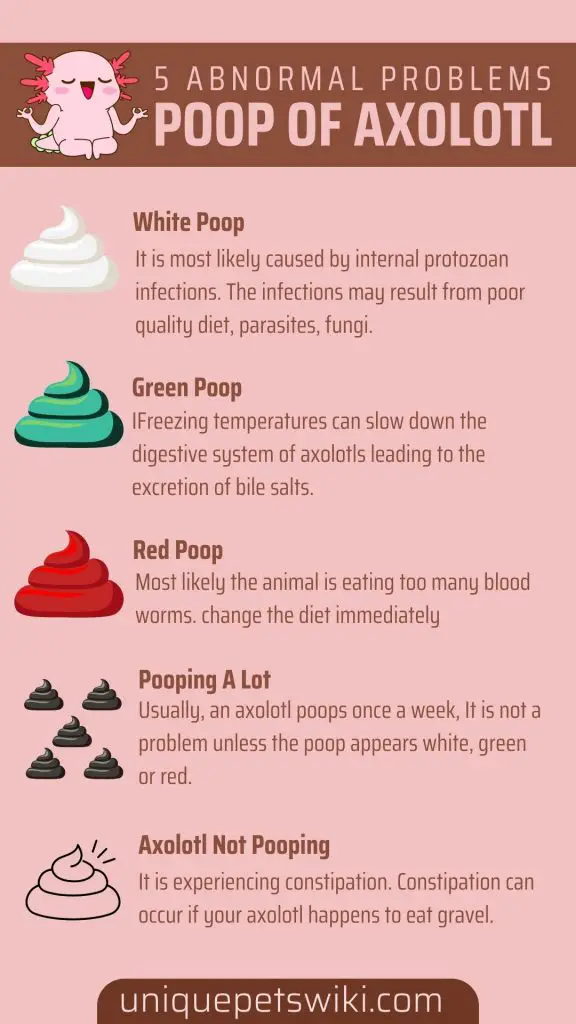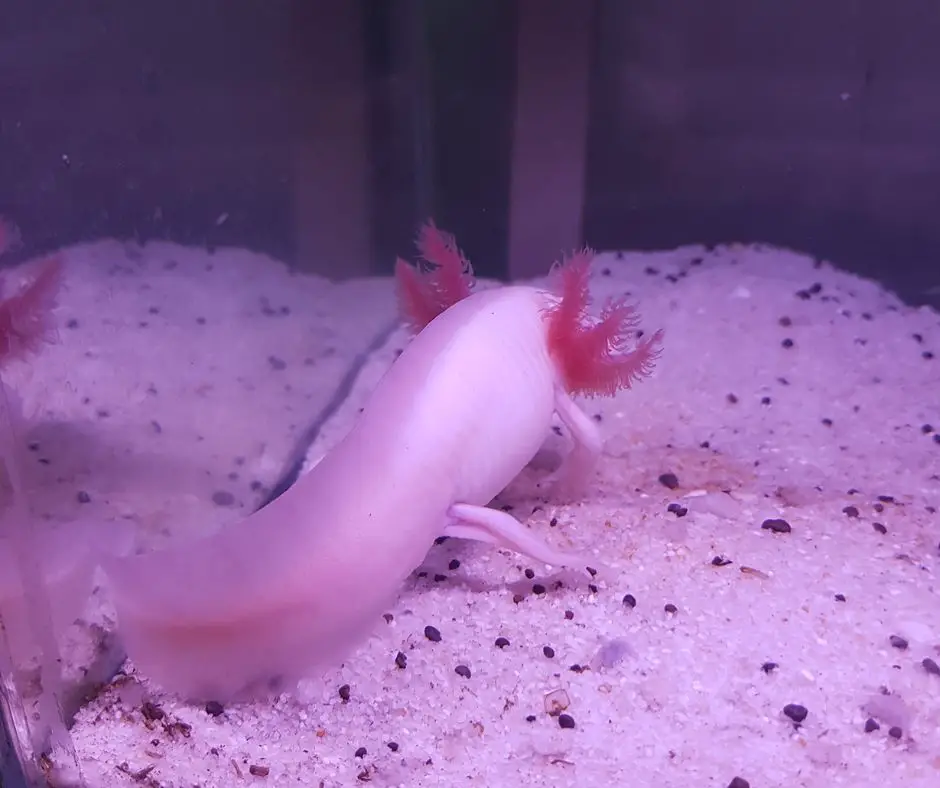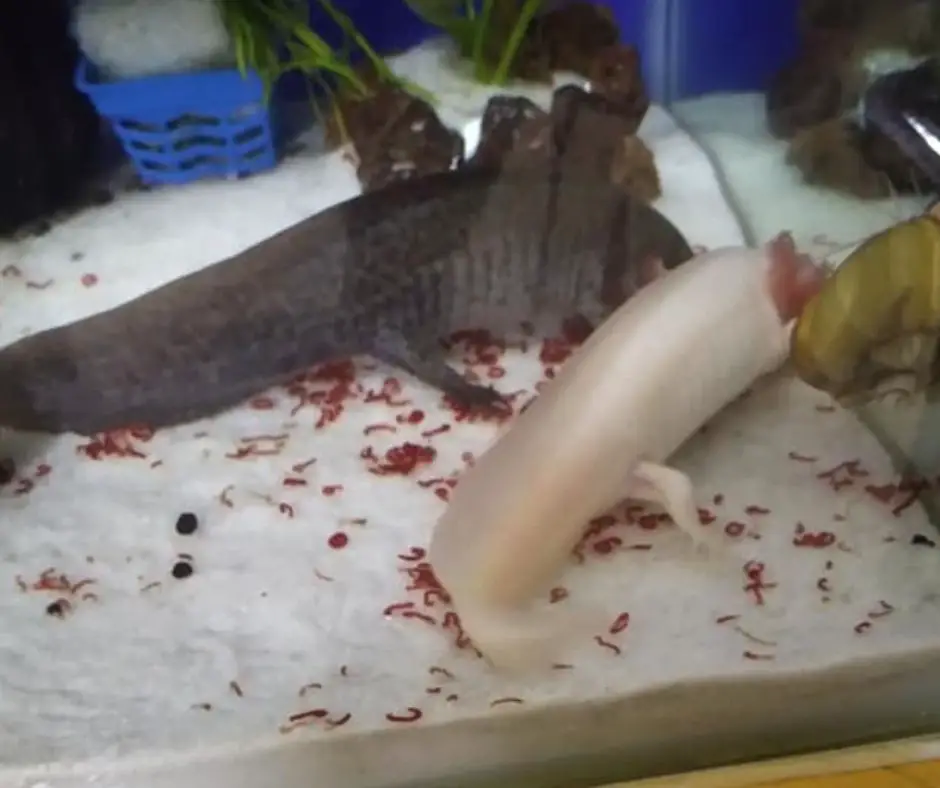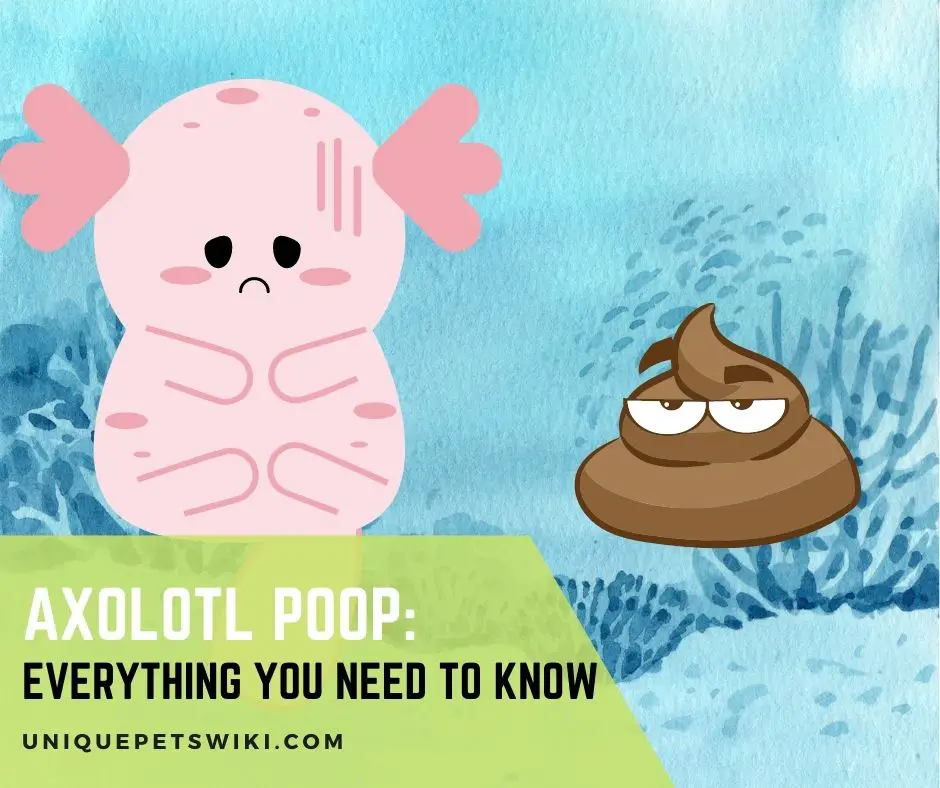Keeping an axolotl as a pet is fun, but it can also be challenging. As an axolotl owner, you have to be careful about the health and well-being of your little friend.
And that includes learning about the excretion process of these salamanders.
Axolotl owners often ask these questions: do axolotls poop? What does it look like? Needless to say, these questions are highly relevant.
Taking care of axolotls is easier if you understand at least the basics of their biology.
In this post, we are going to discuss everything you need to know about axolotl poop. Hopefully you will find answers to some nagging questions here. Keep reading!
Contents
Do Axolotls Poop And Pee?
Yes, axolotls poop and pee. The amount and frequency depend on factors such as the animal’s diet, overall health status and age, and the water temperature in the tank.
These salamanders urinate only about 50% of their metabolic waste. The rest of their metabolic waste is released through their gills.
What Does Axolotl Poop Look Like?
To some extent, the appearance of axolotl poop depends on the age and size of the axolotl.
The stools of baby axolotls look like brown pellets. When handled directly, the poop is liquidy and messy.
The stools of juvenile axolotls look like goatskin. It is much like the poop of a tiger salamander, but a bit more consistent.
The poop fades and dissolves after a while. As we have stated, it is very liquidy. So, if you poke or handle it directly, it will burst and dissolve quickly.
Also read: What Does Axolotl Poop Look Like?
How Do I Get My Axolotl To Poop?
There are two signs that indicate your axolotl wants to poop. First, the gills turn red. And second, the animal will change its posture.
If your axolotl stops pooping, it’s important to find out the underlying reason (more on that later).
Do Axolotl Eat Their Own Poop?
Axolotls are silly creatures; they tend to eat everything they come across, and that includes their poop.
They engage in this behavior especially when food is scarce in the tank. They also scatter the poop everywhere.
As soon as you notice poop, remove it from the tank because your axie may suffer from parasite infections if it eats its own poop. Consider using a plastic baster to suck up the poop.
Also read: How To Clean Axolotl Poop: 3 Basic Ways
5 Abnormal Problems Poop of Axolotl
You can tell a lot about the overall health and well-being of your axolotl just by observing the color and appearance of its poop.
Ensuring the proper functioning of your axolotl’s digestive tract is of utmost importance, so make sure you learn about the excretion patterns of your little dragon.

White Poop
If your axolotl’s poop is white in color, it is most likely caused by internal protozoan infections.
The infections may result from poor quality diet. Problems like parasites, fungi, and infections should be addressed quickly, because they can become fatal.
If the condition persists, take the animal to a veterinarian without delay. The veterinarian may administer antiseptic and antibiotics.
If left untreated, the condition will significantly reduce your axolotl’s immunity, and the animal will lose weight rapidly. In some cases, The problem can even lead to death.
Also read: Why Did My Axolotl Die Suddenly?
Green Poop
If the color of your axolotl’s poop is green, don’t worry. The salamander is just passing out bile salts.
Freezing temperatures can slow down the digestive system of axolotls, leading to the excretion of bile salts.
The solution is simple: just feed your little friend regularly. If the axolotl gets hungry, it may indulge in cannibalistic behaviors, attacking other axolotls in the tank.
Although axolotls can go without food for as long as three weeks, make sure you provide food regularly.
Also read: How Long Can Axolotls Go Without Food?
Red Poop
If your axolotl’s poop appears red, most likely the animal is eating too many blood worms. So, change the diet immediately. Black worms and earthworms are better alternatives.
Choose pellets that are not artificially flavored. If the problem persists, take your axolotl to a veterinarian.
Also read: 4 Best Axolotl Food Pellets
Pooping A Lot
Usually, an axolotl poops once a week. However, the frequency depends on their diet. In this regard, not all axolotls are the same.
Some axolotls release poop little by little while others poop in large chunks.
Don’t worry if your little friend poops a lot. It is not a problem unless the poop appears white, green or red.
But it can rapidly change the water parameters in the tank, and that can be an issue. Feed your axolotl less frequently and the problem will be resolved.
Laifoo Aquarium Siphon Vacuum Cleaner
- FUNCTION --- Easy to control, convenient to siphon fish faeces, impurities, turbid water out of fish tank.
- 5 Feet HOSE --- Made from clear & elastic plastic. Makes it more durable and anti-kinking. Harmless to fishes & No peculiar smell.
- GRAVEL TUBE --- Sinkable, with a detachable filter screen inside. Will not disturb fish or decor when it's working.
- SIPHON BALL --- All you need to do is to pinch it several times, water will flow out automatically. Without striking a blowing.
- WARRANTY --- For 3 months after the date of purchase, we take care of all quality-related issues with a FREE replacement or refund. If you have any questions, do not hesitate to contact our professional after-sale service.
Last update on 2022-12-29 / Affiliate links / Images from Amazon Product Advertising API
Axolotl Not Pooping
An axolotl may stop pooping if the food the animal eats gets blocked up. Constipation can occur if your axolotl happens to eat gravel.
In most cases, gravel comes out as poop. But in some cases, it can cause death.
If you notice that your axolotl has not pooped for more than a week, it is experiencing constipation.
To help your axolotl recover from the problem, stop feeding the animal. Also, lower the temperature of the tank water.
Refusal to eat, inactivity, abdominal swelling, and excessive floating are some signs of constipation in axolotls. If the issue is severe, lowering the temperature of the tank water may not work.
In such a case, consider fridging your axolotl for a few hours. Staying in the fridge, the animal will take about a day to expel its poop.
The key is to keep the animal in cooler temperatures, which facilitate the peristaltic movements.
Once the problem has been revoked, change the diet of your axolotl. Shrimp and bloodworms are great for smooth bowel movements.
How often Does an Axolotl Poop?

To some extent, it depends on the type and frequency of your axolotl’s diet. It also depends on other factors such as your axolotl’s and, overall health condition, and the water temperature in the tank.
A healthy axolotl, if it eats every two or three days, usually poops once a week.
And if the animal eats twice a day, it may poop every day. You will have to observe and figure out the excretion pattern of your axolotl.
If the frequency is irregular, setting up a cleaning schedule can be tricky. In such a case, it is advised that you clean whenever you see the poop.
As an axolotl owner, make it a point to clean axolotl poop regularly. Your axolotl’s well-being and life expectancy largely depends on the quality of water in the tank.
Once your axolotl has finished its poop, it will go elsewhere. Avoid holding the stool directly. If you do so, it will burst. A gravel vacuum cleaner will make your job a lot easier.
Uneaten food is more solid than poop, and can quickly increase the ammonia levels in the water. Therefore, clean uneaten food if there is any.
To reduce the unpleasant smell of the poop, consider using activated carbon. Dead fish and debris will contaminate the tank.
So, clean them up without delay. Make sure there is no ammonia in the tank. The NH3 level should be at 0 ppm. Consider using ammonia test strips to measure the level of NH3.
The key is to understand the unique pattern of your axolotl’s excretion, set a cleaning schedule accordingly, and keep the tank water clean.
How to Help Your Axolotl Poop
As we have already stated, impaction and overfeeding cause constipation in axolotls. To help your axolotl poop, it is important to understand the reason behind the issue.
In simple terms, impaction is intestinal blockage. If your axolotl eats something like fake plants, rocks, and tank decor and fails to digest it, impaction happens.
The animal may willingly eat these things or accidentally swallow them. The symptoms of impaction include passing little or no stool, reduced appetite, and bloating.
Overfeeding is another likely cause of constipation in axolotls. If this is the first time you are keeping an axolotl as a pet, you may end up overfeeding your little friend.
Symptoms of overfeeding include bloating, abnormal floating, and frequent pooping.
However, in some cases, overfeeding can lead to the opposite of frequent pooping—which means little or no pooping.

If you are sure that your axie’s constipation is caused by impaction, you can try either or both of these two treatment options: fridging and surgery.
The process of fridging involves placing your axie in some dechlorinated water and then transferring the animal to a fridge.
Slower temperatures will slow down the metabolism of your axolotl, making it easy for the axie to purge any waste.
If the problem persists, you will have to take your little friend to a vet. The veterinarian will use an X-ray to find the blockage, and then perform surgery.
If your axolotl’s constipation is caused by overfeeding, the treatment is easier. First of all, stop feeding your axie for a few days.
And once the waste has passed out, resume feeding but make sure the frequency is significantly reduced.
Feed earthworms, shrimp, pellets and bloodworms to your axolotl. They help prevent constipation.
Also read: What Can Axolotl Eat?
API TEST KIT
- For fresh and Saltwater
- Monitor ammonia levels
- Helps prevent Fish loss
Last update on 2022-12-29 / Affiliate links / Images from Amazon Product Advertising API
]Wrapping Up
Keeping an axolotl as a pet involves some responsibility.
If you are serious about the health and well-being of your axie, you are expected to know the basics of their care and maintenance, and that includes learning about their poop.
We have discussed everything you might need to know about axolotl poop.
We hope you have found the info helpful, and you will make informed decisions when taking care of your little friend.


